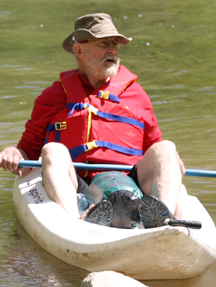Wabash College faculty, staff, and students joined with Mike Bachner's family members for a touching memorial service Tuesday morning in the Chapel.
Wabash Magazine Editor Steve Charles wrote a column for the Crawfordsville Journal Review reflecting on the bookstore manager, Wabash man, and friend:
Maybe it was because he ran the college bookstore, maybe it was just his gregarious nature, but for almost three decades Mike Bachner was the most accessible man on the Wabash campus.
Students, professors, alumni, folks from town—we all stopped by. Sometimes to look at books, but sometimes, I’ll admit, just to talk with Mike. You could be yourself with him—laugh with him, learn from him, disagree with him, think out loud with him, even let out a hearty "Aarrgh!" on Pirate Day with him (After all, he had invented the holiday). He would never let you forget how much fun it was to play.
Maybe that’s why, when we got news of Mike’s death last Tuesday, many of us felt kicked in the gut.
Not Mike, I thought. Not now. Not when everything that mattered so much to him—his family, his work with students, and the land in Montgomery County he enjoyed so much—were all coming together so beautifully, shining such a light for our students and faculty. Not when his passion for his beloved Sugar Creek was inspiring even acclaimed writers like Terry Tempest Williams, who wrote after Mike and his wife, Pat Galloway, guided her through Shades State Park: "Wildness resides in the heart of America."

In a culture beset with deadlines, keeping pace, and rushing around, Mike taught us to slow down. In his remarkable Chapel Speech of March 2005, Mike urged us to "revel in this moment of life. Be sure you know a few things that bring you joy. Make those things why you are here."
I know some of the things that brought Mike joy, why he was here.
First, there was home. Though Mike had good friends and loved Sugar Creek, his family had first claim on his heart. Pat was at its center. I remember standing with Mike as Pat taught my daughter horseback riding. I said something about how good Pat was at this. "No," Mike said. "She’s amazing."
The slow food movement, sustainability, and flexible work schedules seem like good ideas today, but Mike and Pat have lived that way for decades. Mike struck a balance between office and home, physical labor and contemplation, like no else I’ve known. With vision, perseverance, a sense of humor, and no few misadventures, Pat and Mike planted and cultivated a good life.
Their daughters Fern and Madeline are the great rewards of that life. It takes a rare combination of daring and nurture to raise daughters so strong, so much their own persons. If you walked into Mike and Pat’s house and heard Mike on the phone, laughing, it was usually Fern or Madeline on the other end of the line. I once dropped Mike and Madeline at the Jim Davis Bridge for a paddle down Sugar Creek and caught a glimpse of Mike as he watched his daughter take off upstream, paddling effortlessly through the strong spring current. The look on his face said more than any words he could have spoken.
Wabash was a great place for a man always asking questions and so open to wonder, Mike’s practical wisdom and his balanced life so rooted in the Montgomery County soil were good for a place tempted to live in the clouds. He was a man of strong conviction, but for Mike, friendship trumped ideology. That was good for Wabash, too.
Technically, Mike wasn’t a faculty member, so when the Journal-Review ran news of his death under the heading, "Faculty Member Mourned at Wabash," I had to smile. In fact, the JR got it just right—Mike was a teacher here. His classroom just happened to be a creek and a bookstore.
Mike believed in the power of books to open minds and stir the imagination. He was a good storyteller, too. His repertoire included the lore of Sugar Creek and its Wabash connections, all shared with students and faculty as he gave kayak tours as part of the College’s Experience Indiana program. He was getting good at convincing others to tell their stories, too. Wabash Magazine just published works by two students that he helped navigate 400 miles down the Wabash River last summer.
In winter, Sugar Creek became all his. I dropped him off there one December afternoon. A foot of snow obscured the bank, and thin ice at the edge made the usual entry impossible. So Mike got into his kayak on the bank about 20 feet above the creek, aimed it toward the water, and told me to push. Then like an otter down a snowbank, he slid into the creek with a splash.
"Thanks for dropping me off," he said. "See ya."
Mike wrote this about that day:
"Sliding 20 feet down the snowy bank, spraying into the flow,
I’m immediately immersed, floating in a sparkling world
of ice and snow and water.
Red-tailed hawks serenely soar above, watching
Belted kingfishers scold me off their piece of creek side real estate
I’m not alone, but I find some refuge."
The Trappist monk Thomas Merton wrote that we seek solitude not to escape the world, but to return better able to love those in it. That’s what Mike brought back from those hours on Sugar Creek. And for more than three decades, we had free access to it. All you had to do was stop by the bookstore.
I can't imagine this place without him.